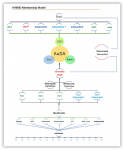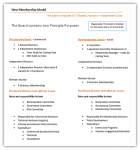Scott.L
Top Contributor

This morning, I submitted to the CMWG a Membership Model composed of Both Constituency and Single Member Models - Hybrid Member Model.
The concept is basic and should resist stacking and capture; obviously, it can be 'gamed' and 'played' and I haven't comprehended everything that could be exploited in this model. Its here for everyone's criticism [make it stronger] - I guess, compromising on both Models and constructing a 3rd lends itself to a type of cooperation of concepts which may or may not be accepted by the members, but hey, at least its a crack at it.

the auDA Board is a Commercial Board composed of 7 Directors and The Membership Council is composed of 5 elected Councilors responsible for Social cohesion between Management and Members. The corporate structure is holistic, in so far as the Council has a say in the decisions of the auDA Board and the auDA Board can have a say in the Membership Councils programs, policy and agenda.
Membership:
Membership composed of industry representation, Legal Persons, and independent representation and no classes supply and demand exist.
- Composed of both legal persons (companies) and individuals (natural persons) from an Opt-Out system of automatic membership upon domain registration or;
- Voluntary OPT- In, Non-Registrant, is charged at $55.00 per-person and $175.00 per-Entity annually. No Member can pay the cost for Voluntary membership of another party.
a) Members are Australian Citizens.
b) Members are over 18 years of Age
c) Members are not subject to probity checks. [unless a candidate for election]
d) Membership is yearly
e) Membership is via Opt-Out at registration – Opt-In is chargeable at auDA Board discretion.
f) A Member exercises One Vote per Legal Person at elections.
g) Membership is non-transferable to any other legal person.
h) Membership assignment to Membership Group Representative (MGR) is transferable once every year prior to June 30th.
i) Membership eligibility to Vote in Elections – 28 days.
j) Members must not enter into voting agreements with other members, including Members as employees or employers of a Legal Person or its subsidiaries. {companies cannot self-elect}
k) Members are not employees of auDA or public servants of the commonwealth, unless permitted by the commonwealth to hold a membership, or permitted by the Commonwealth to vote at company meetings as an authorized representative.
l) A member is assigned One Vote for Membership Council Elections and;
m) A Member is assigned One Vote for auDA Board Elections under the Corporations Act 2001;
m) Councillor Elections are not subject to the Corporations Act 203D or 249D.
n) Any new industry group wishing to establish itself as a Membership Group Representative (MGR) may apply to the Membership Council for inclusion, the Membership Council will vote. Any equality of vote occurring, a casting Vote is made by the Government Appointed Representative.
Membership assignment;
The Membership is filtered via electronic mechanism, utilizing a system of defined questions for those who seek to participate on Committees and Panels; including, nomination to Membership Council Board (MCB). (as per Government Review recommendation 10) and;
Each Legal Person is filtered via an automated electronic platform. Based on voluntary information a member is automatically assigned to one of the Member Group Representative (MGR) according to their responses via the Opt-In system of assessment – .i.e. 3 multiple choice questions related to their employ or business.

For more information: Read the complete CMWG Submission attached - Here







